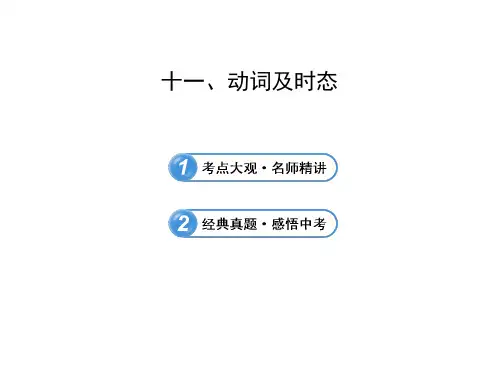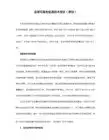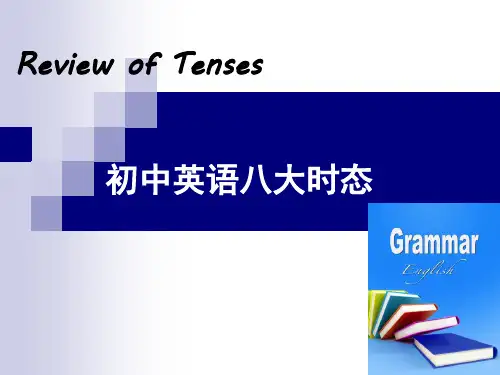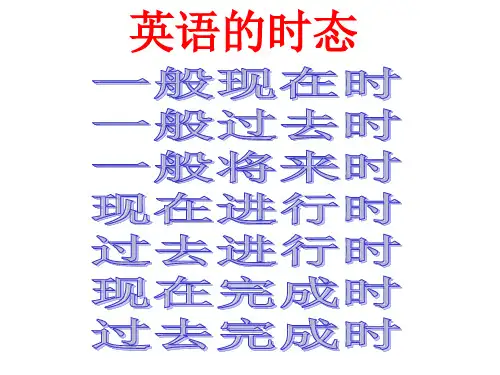- 1、下载文档前请自行甄别文档内容的完整性,平台不提供额外的编辑、内容补充、找答案等附加服务。
- 2、"仅部分预览"的文档,不可在线预览部分如存在完整性等问题,可反馈申请退款(可完整预览的文档不适用该条件!)。
- 3、如文档侵犯您的权益,请联系客服反馈,我们会尽快为您处理(人工客服工作时间:9:00-18:30)。
1. He____(be, was, were, been) here a moment ago. 2. They ____(be, was, were, been) here just now. 3. The scientists _____(leave, leaves, leaved, left) for America yesterday.
6. 用法:现在进行时表示
⑤在时间状语从句和条件状语从 句中,主句用一般将来时(will+ 动词原形),从句中用一般现在 时表将来。(主将从现)
当主语是第三人称时, 谓语动词要用第三人称 单数形式,加-s/es。除 此之外都用动词原形。
动词第三人称单数 形式变化规则
1. He______(be, am, is, are) a teacher at No. 2 Middle School. 2. He______(have, has) classes in the afternoon. 3. He______(get, gets) up at half past six every morning. 4. He always _____(come, comes ) to school on time. 5. He ______(study, studies) very hard at his lesson.
一般过去时
概念:过去某个时间里发生的动作或 状态;过去习惯性、经常性的动作、 行为。 时间状语:ago, yesterday, the day before yesterday, last week(year, night, month…), in 1989, just now, at the age of 5, one day, long long ago, once upon a time, etc.
否定形式:①am/is/are+not;②此时态的 谓语动词若为行为动词,则在其前加 don't,如主语为第三人称单数,则用 doesn't,同时还原行为动词。 一般疑问句:①把be动词放于句首;② 用助动词do提问,如主语为第三人称单 数,则用does,同时,还原行为动词。
什么情况下用?
①表示经常或习惯性的动作或存在 的状态。②表示主语通常的能力、 兴趣爱好、和性格特征。③表示客 观的事实或真理。④表示按照时刻 表或已经计划安排好的将来行为。 (只限于是go, come, leave, arrive, begin, start, take off, stop, be等表示开 始或移动意义的词。)
现在进行时
作语的动词用来表示动作(情况) 发生时间的各种形式称为时态。
1.概念:表示现阶段或说话时正在进 行的动作及行为。 2.时间状语:Now, at this time, days, look. listen等时间状语做标志。
3.基本结构:主语+be +doing +其他 4.否定形式:主语+be +not +doing+ 其他 5.一般疑问句:把be动词放于句首。
初中语法专题(一)
一般现在时 一般过去时 现在进行时 过去进行时 现在完成时 过去完成时 一般将来时 过去将来时
一般现在时
一、一般现在时:
概念:经常、反复发生的动作或行为 及现在的某种状况。 时间状语: always, usually, often, sometimes, every week (day, year, month…), once a week, on Sundays, etc. 基本结构:①be动词;②行为动词
10. I will go there when I _____(have, will have, has) time tomorrow. 11. He won’t come to the party unless he _____(be, will be, am, is, are) invited. 12. I’ll wait here until my mother ____(come, comes, will come) back. 13. Please return the book to the library as soon as you ______(finish, finishes, will finish) reading it. 14. Once you _____(see, sees, will see) him, you will never forget him.
基本结构:①be动词;②行为动词 否定形式:①was/were+not;②在行为 动词前加didn't,同时还原行为动词。 一般疑问句:①was或were放于句首; ②用助动词do的过去式did 提问,同时 还原行为动词。
谓语动词使用过去式形式, 加ed,分为规则和不规则变 化。表示过去经常发生的 动作,也可用“used to do ”和“would +动词原形”。
4. Last week we ______(visit, visited ) the Science Museum. 5. When I was a child, I often ____(play, played) football. 6. The students ran out of the classroom as soon as the bell ____(ring, rang, rung).
6. One and two _____(be, is, are) three. 7. Blue and yellow _____(make, makes) green. 8. The earth _____(move, moves) round the sun. 9. I will go there if I ____( be, will be, am, is, are) free tomorrow.










